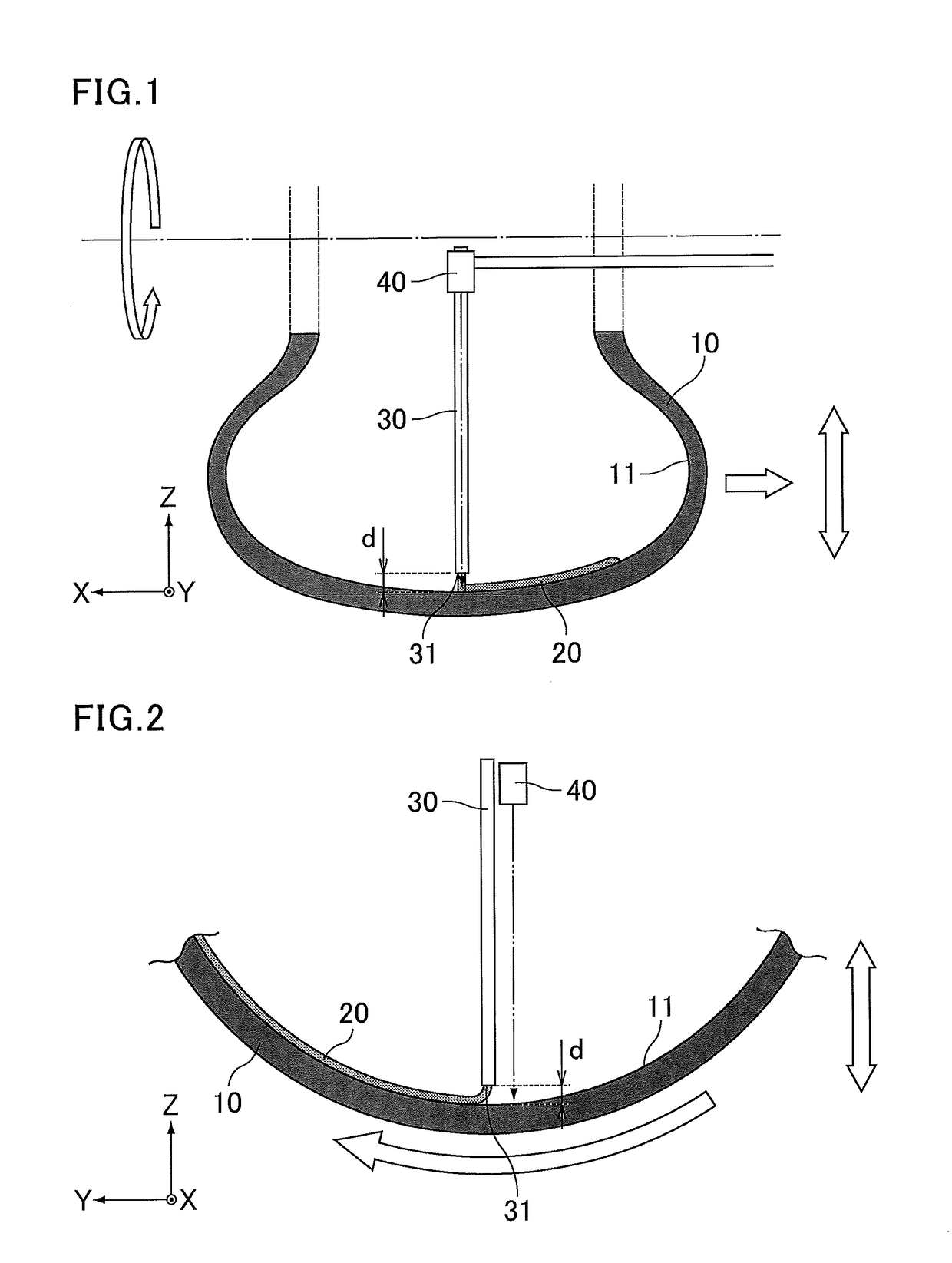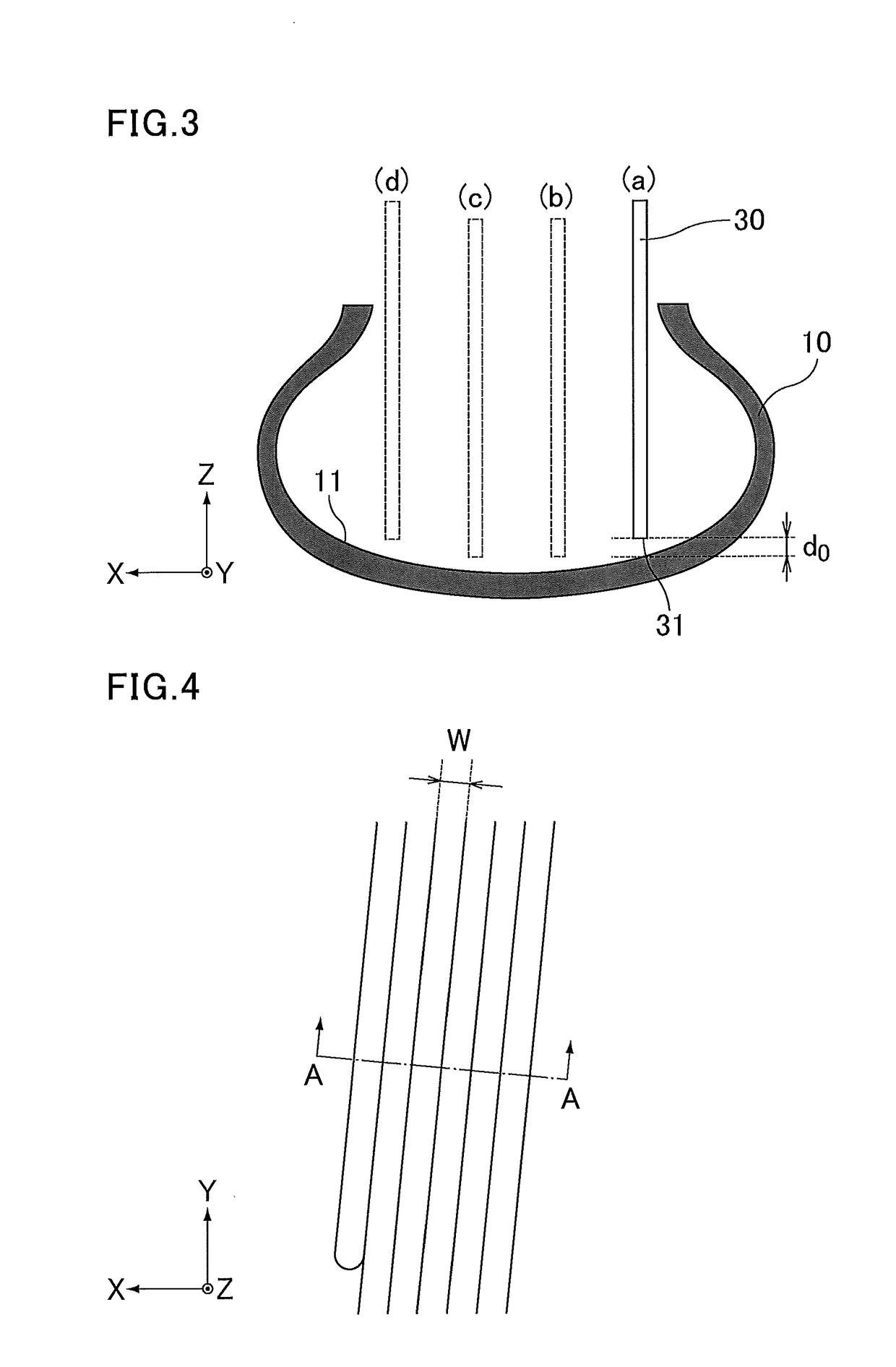Pneumatic tire
a technology of pneumatic tires and sealants, which is applied in the field of pneumatic tires, can solve the problems of vibration or insufficient sealing performance, insufficient adhesion of sealants to the inner periphery of tires, and insufficient sealing performance, and achieve the effect of sufficient sealing performan
- Summary
- Abstract
- Description
- Claims
- Application Information
AI Technical Summary
Benefits of technology
Problems solved by technology
Method used
Image
Examples
first embodiment
[0126]According to a first embodiment, a self-sealing tire can be produced, for example, by performing the Steps (1), (2), and (3) below in the process of applying an adhesive sealant through a nozzle to the inner periphery of a tire while rotating the tire and simultaneously moving at least one of the tire and nozzle in the width direction of the tire: Step (1) of measuring the distance between the inner periphery of the tire and the tip of the nozzle using a non-contact displacement sensor; Step (2) of moving at least one of the tire and nozzle in the radial direction of the tire according to the measurement to adjust the distance between the inner periphery of the tire and the tip of the nozzle to a predetermined length; and Step (3) of applying the sealant to the inner periphery of the tire after the distance is adjusted.
[0127]The distance between the inner periphery of the tire and the tip of the nozzle can be maintained at a constant length by measuring the distance between th...
second embodiment
[0188]The studies of the present inventors have further revealed that the use of the method according to the first embodiment alone has the following disadvantage: a sealant having a generally string shape is occasionally difficult to attach to the inner periphery of a tire and can easily peel off especially at the attachment start portion. A second embodiment is characterized in that in the method for producing a self-sealing tire, the sealant is attached under conditions where the distance between the inner periphery of the tire and the tip of the nozzle is adjusted to a distance d1 and then to a distance d2 larger than the distance d1. In this case, the distance between the inner periphery of the tire and the tip of the nozzle is shortened at the beginning of the attachment, so that the width of the sealant corresponding to the attachment start portion can be increased. As a result, a self-sealing tire can be easily produced in which a generally string-shaped adhesive sealant is ...
third embodiment
[0219]The studies of the present inventors have further revealed that the use of the method according to the first embodiment alone has the following disadvantage: a sealant having a generally string shape is occasionally difficult to attach to the inner periphery of a tire and can easily peel off especially at the attachment start portion. The studies of the present inventors have still further revealed that, if the attachment start portion of the sealant is peeled, unfortunately the peeled portion may not show sufficient sealing performance, and thus sufficient sealing performance cannot be obtained on the entire sealant layer.
[0220]In order to solve these problems, the attachment start portion of the sealant is adapted to be located tire-widthwise inward from the tire-widthwise end of the sealant layer as shown in FIG. 10(d). This allows the entire sealant layer to have sufficient sealing performance even when the attachment start portion of the sealant is peeled.
[0221]More speci...
PUM
| Property | Measurement | Unit |
|---|---|---|
| temperature | aaaaa | aaaaa |
| width | aaaaa | aaaaa |
| area | aaaaa | aaaaa |
Abstract
Description
Claims
Application Information
 Login to View More
Login to View More - R&D
- Intellectual Property
- Life Sciences
- Materials
- Tech Scout
- Unparalleled Data Quality
- Higher Quality Content
- 60% Fewer Hallucinations
Browse by: Latest US Patents, China's latest patents, Technical Efficacy Thesaurus, Application Domain, Technology Topic, Popular Technical Reports.
© 2025 PatSnap. All rights reserved.Legal|Privacy policy|Modern Slavery Act Transparency Statement|Sitemap|About US| Contact US: help@patsnap.com



